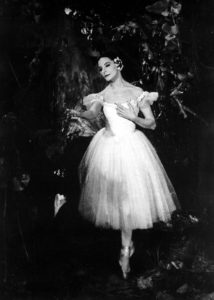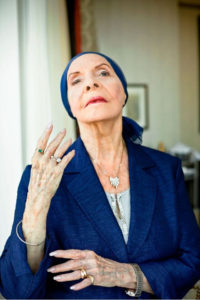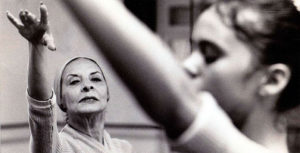Alicia Alonso: The passing of Cuba’s uncrowned queen - Vancouver Ballet Society
- Home
- Features 2020 - 2023
- Alicia Alonso: The passing of Cuba’s uncrowned queen

By Michael Crabb
Alicia Alonso, the iconic Cuban ballerina who died in October, had extraordinary fingers. In conversation you could judge her mood and reactions more accurately through their articulations than by attempting to read her facial expressions. All great dancers cultivate expressiveness in their hands but with Alonso it was more personal.

In her early twenties, when she was afflicted with eye problems that left her almost blind, Alonso was obliged for months to remain motionless in a hospital bed. Rather than dwell on what most would have assumed was the end of a budding dance career, Alonso imagined herself as Giselle, using her hands and fingers as proxies for legs and arms as she worked out what was to become one of her most legendary roles. It speaks to the power of imagination and force of will that propelled Alonso to international stardom and enabled her to make her Cuban homeland a major player in the world of ballet.
Alicia Alonso was not averse to being described as a living legend. She cultivated her iconic status because it helped her get what she wanted, to establish the institutions upon which she could build a classical ballet tradition in Cuba. As with most legends, it is not easy to distinguish fact from fiction. In Alonso’s case the problem is exacerbated because the contours of her life from 1959 onward were highly politicized. By choosing to align herself with Fidel Castro and the Cuban Revolution, Alonso automatically acquired enemies among those who did not. Thus, while at home she became a cultural heroine with a state-funded ballet company and school at her disposal, Cuban exiles reviled her as an egomaniacal opportunist willing to make a pact with the devil.
This, of course, is a gross distortion. If Alonso had had no more than personal interest in mind, prudence might have suggested she remain where her career began, in New York. That’s where, after initial training in Havana, she had eloped as a pregnant teenager with her first husband, Fernando Alonso, because Cuba offered no prospect of a professional career. After her breakthrough 1943 Ballet Theatre debut as Giselle, replacing an injured Alicia Markova, Alonso emerged as one of the most dazzlingly accomplished and versatile ballerinas of her generation. Along with her husband and his brother, choreographer Alberto Alonso, she used her fame and not inconsiderable earnings to establish her first company in Havana in 1948. It was a time of growing popular unrest, and when Fulgencio Batista became Cuba’s American-backed military dictator in 1952, Alonso’s sense of patriotic revulsion was genuine. Like many Cubans, Alonso saw Batista’s eventual overthrow as a new dawn for the post-colonial island, one filled with utopian dreams in which art and culture would play a major role.

At age 39, Alicia Alonso was also likely doing what many ballerinas of that age are forced to do, thinking about what comes next. The Revolution offered exciting prospects, but they were clouded by uncertainty. Human nature is inevitably complex and self-delusion one of its most recurrent characteristics, but Alonso’s fateful decision in 1959 to align with Castro was as much fired by idealism as any promise of personal advantage.
Not that she didn’t take personal advantage. Alonso ruled the newly instituted Ballet Nacional de Cuba with a rod of iron and came to believe, not unreasonably, that its fortunes were tightly linked to her celebrity and charisma. This, in her mind, meant she had to remain in the public eye, onstage. “Is Alonso still dancing?” became a ballet-world joke decades before, in her seventies, she reluctantly hung up her pointe shoes. Even then, the cult of personality continued. Alonso’s public appearances always had a regal penumbra. She was Cuba’s uncrowned queen. Even the President of the Republic kissed her hand.
Notoriously, Alonso would brook no opposition or competition and her friendship with the Castros gave her decisions the weight of imperial commands. To gainsay Alonso was to risk excommunication. Alonso was given free rein to run the BNC in ways that thwarted the ambitions of rising talents, particularly younger ballerinas, and prompted a steady exodus of dancers, some with official blessing but most through defection.
Many Cubans have defected, most to escape the routine hardships of their everyday existence. The BNC’s dancers, however, have it relatively easy. They are paid meagrely but regularly, lunch is provided and, unless they are considered a serious flight risk, they get to tour abroad. The best among them, such as Viengsay Valdés, who now heads the company, have emerged as stars in their own right. What prompted the constant stream of defections had more to do with artistic frustration than material ambition.

For all its overseas tours, the BNC, along with its adoring local public, became artistically insular under Alonso’s direction, in part because the company could not afford to engage top-rank foreign choreographers, but also because Alonso’s conception of classical ballet was locked in the aesthetic of a bygone age. The biennial Havana International Ballet Festivals she organized were supposed to display the excellence of the BNC but as the years passed, in comparison with participating troupes from abroad, they more often revealed its dire shortcomings.
One is compelled to ask whether Alonso could imagine a future for Cuban ballet beyond her own existence. She often said she would live to be 200. It was never clear if she was joking. She had no succession plan and, in the end, as age took its inevitable toll, the Ministry of Culture decided to bring some clarity to the BNC’s rudderless condition by naming Valdés as Alonso’s “deputy,” in effect giving her the responsibility and authority to begin the difficult task of equipping the company to survive its founder, which it will.
Alicia Alonso will remain a controversial figure in ballet history but her place in it is nevertheless assured. She established a ballet tradition in the unlikeliest of places and developed a training system that has produced some of the world’s finest dancers. It took courage and determination on an epic scale and it’s hard to imagine anyone other than the fearless and indomitable Alicia Alonso achieving this.
Alicia Alonso (Alicia Ernestina de la Caridad del Cobre Martínez y del Hoyo) born Havana, 21 December 1920; died Havana, 17 October 2019.

